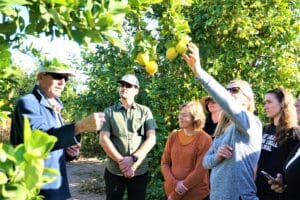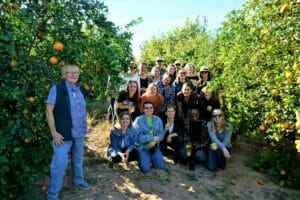
This blog post was written by Arizona State University graduate student Dr. Angel Cruz. In addition to studying Food Policy and Sustainability Leadership at ASU, Angel is the academic and extension initiatives manager at the Center for Environmental Farming Systems (CEFS) at NC State University where she champions sustainable ag education and career development across North Carolina.
My hands were stained a bright lime green as I picked fresh lemons (not limes!) and listened to Mr. Keuchel, owner of the farm we were visiting, explain some of the details of citrus production in Arizona. I was with a group of young leaders from around the country, the ASU Food Policy and Sustainability Leadership cohort, visiting Keuchel Farms on a week-long Arizona food and farm immersion trip.
I stared at the green and yellow lemon, while I learned that most lemons won’t turn yellow on the tree. After harvest, most lemons grown in the US are exposed to ethylene gas so they turn the bright lemon yellow we are accustomed to seeing on the grocery store shelves. After picking a lemon and squeezing it into my water, I realized the slight green color definitely did not impact the flavor. It was one of the juiciest and most flavorful lemons I had ever had. The flavor might have been enhanced by the fact I was standing in a field of lemon trees, learning about citrus production from one of the pioneers, but that lemon was sweet, tart, herbal, and bursting with flavor.
Mr. Keuchel continued telling us that most of his lemons go to Canada and Europe. In the US, the ideal lemon weighs around 58 grams, but a lot of his product are slightly bigger or smaller and the Canadian and European markets accept more diverse fruit sizes. It was shocking to learn that sometimes more than 20% of his harvest isn’t good enough for market – in fact, he informed me that the two lemons I had just picked would be deemed not market worthy. I asked him if he sold the rejects for juice or zest, but he said only when the market is good. Sometimes the juice price isn’t high enough to break even from the cost of harvesting.
An hour after sipping lemon water and touring Mr. Keuchel’s citrus groves, I was sitting beside him in his Jeep Wrangler on our way to a mixed baby greens farm 15 minutes down a dusty road. As we drove, he pointed to multiple housing developments and more than half a dozen lettuce fields that all used to be in citrus production. That 15 minute drive showed me how citrus production in Arizona had declined to less than half what it was in 2012. That means hundreds of family farms, like Mr. Keuchel’s, sold their land to developers or some of the large corporate farms that are moving into the lettuce industry.
It was hard to believe that citrus was once considered one of Arizona’s Five C’s – citrus, cotton, copper, cattle and climate. These Five C’s were the original backbone of the Arizona economy. Unfortunately, today, citrus accounts for less than 1% of the state’s $23 billion agricultural economy. There are many reasons for the decline of citrus, including pests, drought, climate change, increasing labor costs and development. It’s hard to blame just one factor.
Because I’ve never been on a citrus farm in the US, much less picked fresh lemons and oranges, I never thought much about the loss of this unique industry. Now, every time I add a lemon wedge to my water or enjoy a gin and tonic with fresh citrus, I think about where the fruit was grown, who picked it, and even how much it weighed when it was picked. I also can’t help but think it probably isn’t as good as the citrus I had on Mr. Keuchel’s farm in Arizona.
On behalf of the entire ASU Food Policy and Sustainability Cohort, I would like to extend our sincere appreciation to Mark Keuchel and his family for giving us the opportunity to visit and learn more about citrus farming in AZ.
As we navigate these uncertain times it is more important than ever to have a robust network of food and agriculture policy leaders to make sensible and responsible decisions. Could you be one of those people? Learn more about answering this call by checking out the Food Policy and Sustainability Leadership Program at ASU!

